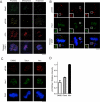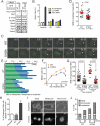Phosphorylation of the Ndc80 complex protein, HEC1, by Nek2 kinase modulates chromosome alignment and signaling of the spindle assembly checkpoint
- PMID: 21832156
- PMCID: PMC3183014
- DOI: 10.1091/mbc.E11-01-0012
Phosphorylation of the Ndc80 complex protein, HEC1, by Nek2 kinase modulates chromosome alignment and signaling of the spindle assembly checkpoint
Abstract
The spindle assemble checkpoint (SAC) is critical for accurate chromosome segregation. Hec1 contributes to chromosome segregation in part by mediating SAC signaling and chromosome alignment. However, the molecular mechanism by which Hec1 modulates checkpoint signaling and alignment remains poorly understood. We found that Hec1 serine 165 (S165) is preferentially phosphorylated at kinetochores. Phosphorylated Hec1 serine 165 (pS165) specifically localized to kinetochores of misaligned chromosomes, showing a spatiotemporal distribution characteristic of SAC molecules. Expressing an RNA interference (RNAi)-resistant S165A mutant in Hec1-depleted cells permitted normal progression to metaphase, but accelerated the metaphase-to-anaphase transition. The S165A cells were defective in Mad1 and Mad2 localization to kinetochores, regardless of attachment status. These cells often entered anaphase with lagging chromosomes and elicited increased segregation errors and cell death. In contrast, expressing S165E mutant in Hec1-depleted cells triggered defective chromosome alignment and severe mitotic arrest associated with increased Mad1/Mad2 signals at prometaphase kinetochores. A small portion of S165E cells eventually bypassed the SAC but showed severe segregation errors. Nek2 is the primary kinase responsible for kinetochore pS165, while PP1 phosphatase may dephosphorylate pS165 during SAC silencing. Taken together, these results suggest that modifications of Hec1 S165 serve as an important mechanism in modulating SAC signaling and chromosome alignment.
Figures







Similar articles
-
Phosphorylation of microtubule-binding protein Hec1 by mitotic kinase Aurora B specifies spindle checkpoint kinase Mps1 signaling at the kinetochore.J Biol Chem. 2013 Dec 13;288(50):36149-59. doi: 10.1074/jbc.M113.507970. Epub 2013 Nov 1. J Biol Chem. 2013. PMID: 24187132 Free PMC article.
-
Constitutive Mad1 targeting to kinetochores uncouples checkpoint signalling from chromosome biorientation.Nat Cell Biol. 2011 Apr;13(4):475-82. doi: 10.1038/ncb2223. Epub 2011 Mar 13. Nat Cell Biol. 2011. PMID: 21394085 Free PMC article.
-
Nuf2 and Hec1 are required for retention of the checkpoint proteins Mad1 and Mad2 to kinetochores.Curr Biol. 2003 Dec 2;13(23):2103-9. doi: 10.1016/j.cub.2003.10.056. Curr Biol. 2003. PMID: 14654001
-
Orchestration of the spindle assembly checkpoint by CDK1-cyclin B1.FEBS Lett. 2019 Oct;593(20):2889-2907. doi: 10.1002/1873-3468.13591. Epub 2019 Sep 13. FEBS Lett. 2019. PMID: 31469407 Review.
-
The spindle checkpoint: a quality control mechanism which ensures accurate chromosome segregation.Chromosome Res. 2004;12(6):599-616. doi: 10.1023/B:CHRO.0000036610.78380.51. Chromosome Res. 2004. PMID: 15289666 Review.
Cited by
-
The Toxoplasma gondii centrosome is the platform for internal daughter budding as revealed by a Nek1 kinase mutant.J Cell Sci. 2013 Aug 1;126(Pt 15):3344-55. doi: 10.1242/jcs.123364. Epub 2013 May 31. J Cell Sci. 2013. PMID: 23729737 Free PMC article.
-
"Stop Ne(c)king around": How interactomics contributes to functionally characterize Nek family kinases.World J Biol Chem. 2014 May 26;5(2):141-60. doi: 10.4331/wjbc.v5.i2.141. World J Biol Chem. 2014. PMID: 24921005 Free PMC article. Review.
-
VTT-006, an anti-mitotic compound, binds to the Ndc80 complex and suppresses cancer cell growth in vitro.Oncoscience. 2021 Dec 10;8:134-153. doi: 10.18632/oncoscience.549. eCollection 2021. Oncoscience. 2021. PMID: 34926718 Free PMC article.
-
The 68-kDa telomeric repeat binding factor 1 (TRF1)-associated protein (TAP68) interacts with and recruits TRF1 to the spindle pole during mitosis.J Biol Chem. 2014 May 16;289(20):14145-56. doi: 10.1074/jbc.M113.526244. Epub 2014 Apr 1. J Biol Chem. 2014. PMID: 24692559 Free PMC article.
-
Signalling dynamics in the spindle checkpoint response.Nat Rev Mol Cell Biol. 2014 Nov;15(11):736-47. doi: 10.1038/nrm3888. Epub 2014 Oct 10. Nat Rev Mol Cell Biol. 2014. PMID: 25303117 Free PMC article. Review.
References
-
- Buffin E, Lefebvre C, Huang J, Gagou ME, Karess RE. Recruitment of Mad2 to the kinetochore requires the Rod/Zw10 complex. Curr Biol. 2005;15:856–861. - PubMed
Publication types
MeSH terms
Substances
Grants and funding
LinkOut - more resources
Full Text Sources
Other Literature Sources
Molecular Biology Databases
Research Materials
Miscellaneous

